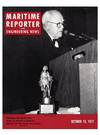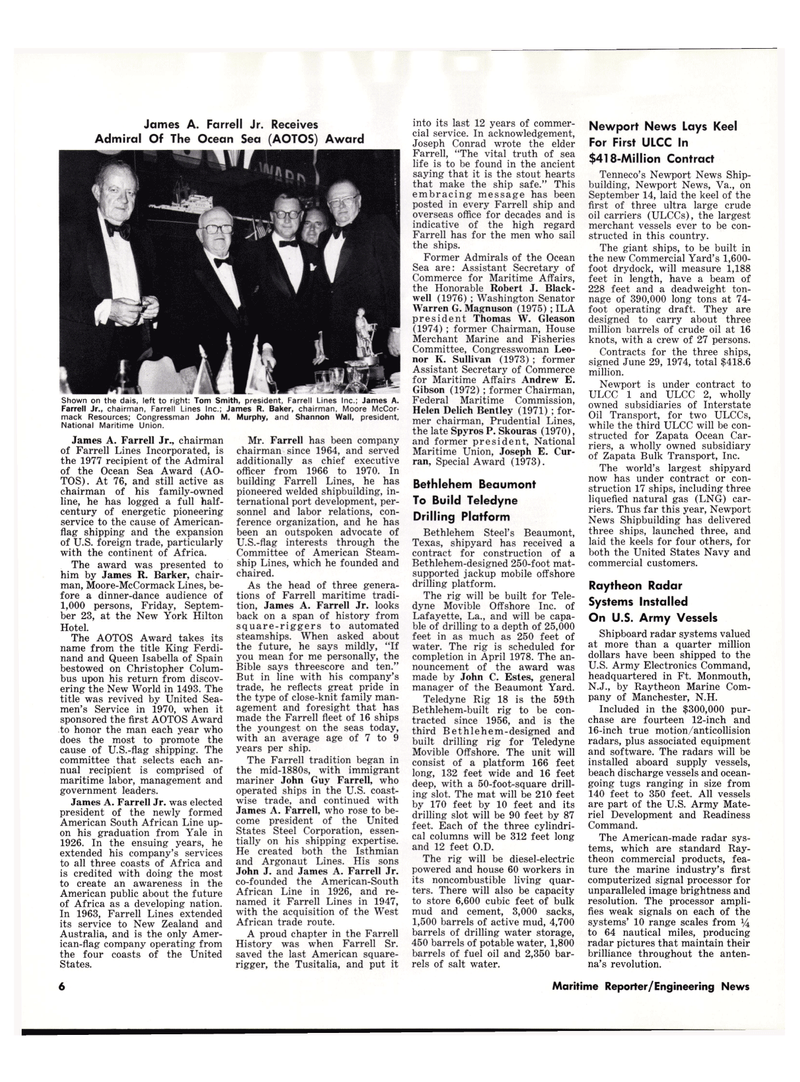
Page 4: of Maritime Reporter Magazine (October 15, 1977)
Read this page in Pdf, Flash or Html5 edition of October 15, 1977 Maritime Reporter Magazine
James A. Farrell Jr. Receives
Admiral Of The Ocean Sea (AOTOS) Award
Shown on the dais, left to right: Tom Smith, president, Farrell Lines Inc.; James A.
Farrell Jr., chairman, Farrell Lines Inc.; James R. Baker, chairman, Moore McCor- mack Resources; Congressman John M. Murphy, and Shannon Wall, president,
National Maritime Union.
James A. Farrell Jr., chairman of Farrell Lines Incorporated, is the 1977 recipient of the Admiral of the Ocean Sea Award (AO-
TOS). At 76, and still active as chairman of his family-owned line, he has logged a full half- century of energetic pioneering service to the cause of American- flag shipping and the expansion of U.S. foreign trade, particularly with the continent of Africa.
The award was presented to him by James R. Barker, chair- man, Moore-McCormack Lines, be- fore a dinner-dance audience of 1,000 persons, Friday, Septem- ber 23, at the New York Hilton
Hotel.
The AOTOS Award takes its name from the title King Ferdi- nand and Queen Isabella of Spain bestowed on Christopher Colum- bus upon his return from discov- ering the New World in 1493. The title was revived by United Sea- men's Service in 1970, when it sponsored the first AOTOS Award to honor the man each year who does the most to promote the cause of U.S.-flag shipping. The committee that selects each an- nual recipient is comprised of maritime labor, management and government leaders.
James A. Farrell Jr. was elected president of the newly formed
American South African Line up- on his graduation from Yale in 1926. In the ensuing years, he extended his company's services to all three coasts of Africa and is credited with doing the most to create an awareness in the
American public about the future of Africa as a developing nation.
In 1963, Farrell Lines extended its service to New Zealand and
Australia, and is the only Amer- ican-flag company operating from the four coasts of the United
States.
Mr. Farrell has been company chairman since 1964, and served additionally as chief executive officer from 1966 to 1970. In building Farrell Lines, he has pioneered welded shipbuilding, in- ternational port development, per- sonnel and labor relations, con- ference organization, and he has been an outspoken advocate of
U.S.-flag interests through the
Committee of American Steam- ship Lines, which he founded and chaired.
As the head of three genera- tions of Farrell maritime tradi- tion, James A. Farrell Jr. looks back on a span of history from square-riggers to automated steamships. When asked about the future, he says mildly, "If you mean for me personally, the
Bible says threescore and ten."
But in line with his company's trade, he reflects great pride in the type of close-knit family man- agement and foresight that has made the Farrell fleet of 16 ships the youngest on the seas today, with an average age of 7 to 9 years per ship.
The Farrell tradition began in the mid-1880s, with immigrant mariner John Guy Farrell, who operated ships in the U.S. coast- wise trade, and continued with
James A. Farrell, who rose to be- come president of the United
States Steel Corporation, essen- tially on his shipping expertise.
He created both the Isthmian and Argonaut Lines. His sons
John J. and James A. Farrell Jr. co-founded the American-South
African Line in 1926, and re- named it Farrell Lines in 1947, with the acquisition of the West
African trade route.
A proud chapter in the Farrell
History was when Farrell Sr. saved the last American square- rigger, the Tusitalia, and put it into its last 12 years of commer- cial service. In acknowledgement,
Joseph Conrad wrote the elder
Farrell, "The vital truth of sea life is to be found in the ancient saying that it is the stout hearts that make the ship safe." This embracing message has been posted in every Farrell ship and overseas office for decades and is indicative of the high regard
Farrell has for the men who sail the ships.
Former Admirals of the Ocean
Sea are: Assistant Secretary of
Commerce for Maritime Affairs, the Honorable Robert J. Black- well (1976) ; Washington Senator
Warren G. Magnuson (1975) ; ILA president Thomas W. Gleason (1974) ; former Chairman, House
Merchant Marine and Fisheries
Committee, Congresswoman Leo- nor K. Sullivan (1973) ; former
Assistant Secretary of Commerce for Maritime Affairs Andrew E.
Gibson (1972) ; former Chairman,
Federal Maritime Commission,
Helen Delich Bentley (1971) ; for- mer chairman, Prudential Lines, the late Spyros P. Skouras (1970), and former president, National
Maritime Union, Joseph E. Cur- ran, Special Award (1973).
Bethlehem Beaumont
To Build Teledyne
Drilling Platform
Bethlehem Steel's Beaumont,
Texas, shipyard has received a contract for construction of a
Bethlehem-designed 250-foot mat- supported jackup mobile offshore drilling platform.
The rig will be built for Tele- dyne Movible Offshore Inc. of
Lafayette, La., and will be capa- ble of drilling to a depth of 25,000 feet in as much as 250 feet of water. The rig is scheduled for completion in April 1978. The an- nouncement of the award was made by John C. Estes, general manager of the Beaumont Yard.
Teledyne Rig 18 is the 59th
Bethlehem-built rig to be con- tracted since 1956, and is the third Bethlehem-designed and built drilling rig for Teledyne
Movible Offshore. The unit will consist of a platform 166 feet long, 132 feet wide and 16 feet deep, with a 50-foot-square drill- ing slot. The mat will be 210 feet by 170 feet by 10 feet and its drilling slot will be 90 feet by 87 feet. Each of the three cylindri- cal columns will be 312 feet long and 12 feet O.D.
The rig will be diesel-electric powered and house 60 workers in its noncombustible living quar- ters. There will also be capacity to store 6,600 cubic feet of bulk mud and cement, 3,000 sacks, 1,500 barrels of active mud, 4,700 barrels of drilling water storage, 450 barrels of potable water, 1,800 barrels of fuel oil and 2,350 bar- rels of salt water.
Newport News Lays Keel
For First ULCC In $418-Million Contract
Tenneco's Newport News Ship- building, Newport News, Va., on
September 14, laid the keel of the first of three ultra large crude oil carriers (ULCCs), the largest merchant vessels ever to be con- structed in this country.
The giant ships, to be built in the new Commercial Yard's 1,600- foot drydock, will measure 1,188 feet in length, have a beam of 228 feet and a deadweight ton- nage of 390,000 long tons at 74- foot operating draft. They are designed to carry about three million barrels of crude oil at 16 knots, with a crew of 27 persons.
Contracts for the three ships, signed June 29, 1974, total $418.6 million.
Newport is under contract to
ULCC 1 and ULCC 2, wholly owned subsidiaries of Interstate
Oil Transport, for two ULCCs, while the third ULCC will be con- structed for Zapata Ocean Car- riers, a wholly owned subsidiary of Zapata Bulk Transport, Inc.
The world's largest shipyard now has under contract or con- struction 17 ships, including three liquefied natural gas (LNG) car- riers. Thus far this year, Newport
News Shipbuilding has delivered three ships, launched three, and laid the keels for four others, for both the United States Navy and commercial customers.
Raytheon Radar
Systems Installed
On U.S. Army Vessels
Shipboard radar systems valued at more than a quarter million dollars have been shipped to the
U.S. Army Electronics Command, headquartered in Ft. Monmouth,
N.J., by Raytheon Marine Com- pany of Manchester, N.H.
Included in the $300,000 pur- chase are fourteen 12-inch and 16-inch true motion/anticollision radars, plus associated equipment and software. The radars will be installed aboard supply vessels, beach discharge vessels and ocean- going tugs ranging in size from 140 feet to 350 feet. All vessels are part of the U.S. Army Mate- riel Development and Readiness
Command.
The American-made radar sys- tems, which are standard Ray- theon commercial products, fea- ture the marine industry's first computerized signal processor for unparalleled image brightness and resolution. The processor ampli- fies weak signals on each of the systems' 10 range scales from to 64 nautical miles, producing radar pictures that maintain their brilliance throughout the anten- na's revolution. 6 Maritime Reporter/Engineering News

 3
3

 5
5
